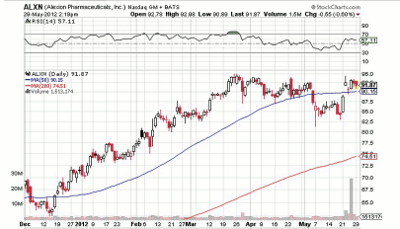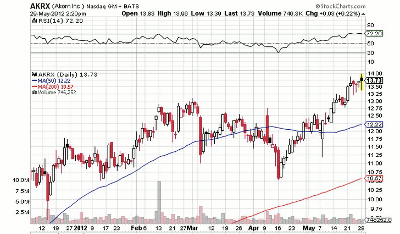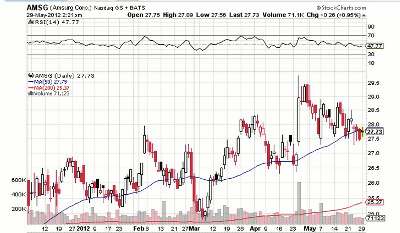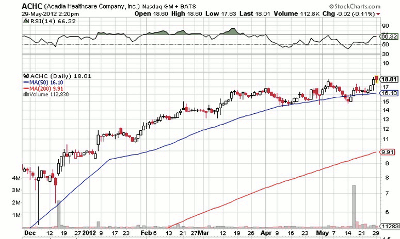Health care has been a sector showing potential for several months, even in the market downturn. Today, MoneyShow’s Kate Stalter looks at four companies with good revenue growth and better-than-average price action.
At almost any given time in recent years, the medical sector has been home to several solid price performers.
Lately, the ranks of medical-industry leaders have included Alexion Pharmaceuticals (ALXN). It’s definitely not a well-known name like Pfizer (PFE) or Bristol-Myers Squibb (BMY), but Alexion is more research-focused than consumer products-focused.
Alexion is a large cap that’s up about 29% so far in 2012, clearly outpacing the major indices in terms of price action. The stock has been consolidating below its March 26 all-time high of $95.01, and may be attempting to rally, although it was pulling back again on Tuesday, trading just above $92.
While Alexion has been a good example of a consistent growth leader since the indices emerged from the bear in March 2009, there are some newer or smaller companies that appear to be asserting leadership.
Akorn (AKRX), which makes pharmaceuticals for the ophthalmological market, among others, has been flirting with new highs in recent weeks. On Tuesday, it rallied to an all-time peak of $13.96, before pulling back sharply to trade at a loss, near $13.49.
Despite the intraday action Tuesday, Akorn’s prospects continue to look bright, based on the recent chart action and the fundamental picture.
The Illinois-based small cap has steadily grown earnings in the past couple of years, after swinging to profitability in 2010. This illustrates why patience is often needed with companies from the pharma and biotech sub-sectors, which are heavily R&D dependent, and frequently show losses for years before generating net income.
Revenue growth at Akorn has accelerated in the past four quarters. Analysts are eyeing income of 54 cents a share this year, up 50% from 2011. Next year, that number is pegged at 68 cents, which would be a gain of 26%. I never rely on analysts’ estimates to make buy or sell decisions, but they can be one indicator of institutional confidence in a company at any given time.
The confidence indicator I do rely on, however, is price action on the chart. Akorn cleared a two-and-a-half-month base on May 14, as its price jumped above resistance at $12.75. Volume was higher than the prior session, another signal that buyers had conviction about the stock.
It’s true that in the past year or so, many stocks have been able to attain new price highs in lower volume, so price remains the key indicator. However, it’s generally preferable to see heavy turnover when a stock clears a consolidation—it often bodes well for future price gains.
Also from the medical sector is small-cap AmSurg (AMSG), a Tennessee company that operates outpatient surgical centers in 35 states. Earnings growth has accelerated in the past three quarters, and the pace of revenue increases has picked up in the past four.
This stock’s market cap is around $878 million, and it trades about 144,000 shares per day, on average, which puts it in the “thin” column. It has a beta of 1.17, illustrating its volatility relative to the broader market.
The stock is getting good support along its 50-day moving average, potentially setting up for further price gains. If mutual-fund and hedge-fund investors continue to hold shares above that medium-term moving average, it could signal that they will add to positions when a market rally re-emerges.
Another company in a similar business is Acadia Healthcare (ACHC), also based in Tennessee. This is also a small company, with a market value of $776 million, and 160,000 shares changing hands per day. It operates behavioral care outpatient centers in 19 states.
Like Akorn, Acadia rallied to a new high as the market raced higher early Tuesday, but retreated along with the indices, and as of mid-session, was showing a moderate gain.
This stock began its Nasdaq trade in November. Since January, it’s rallied 81%. A stock whose price performance outpaces general market action in a downturn is often setting up for a continued rally in the next uptrend.
In addition, it’s worth tracking as a newly public stock. At any given time, a high percentage of market price leaders hail from the ranks of companies that went public within the past decade or so.
Frequently, these price leaders are unheralded small caps that began trading recently. In other words, there is plenty of opportunity among new IPOs other than names like Facebook (FB) that get the lion’s share of media attention.
At the time of publication, Kate Stalter did not own positions in any of the stocks mentioned in this column.
Related Reading:














